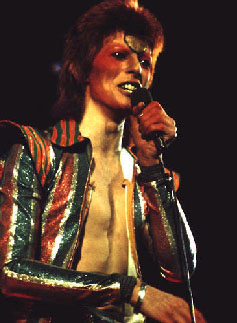

The Roots of Glam Rock
 |
|||||
The Roots of Glam Rock |
|||||
|
Glam performers often dressed androgynously in make up and
glittery, outrageous costumes, not dissimilar to costumes that Liberace or Elvis Presley wore when performing in cabaret.
The most famous example is David Bowie during his Ziggy Stardust phase. Sexual ambiguity became a game; Bowie told the press
he was bisexual simply for the publicity while the late Jobriath is thought really to have been rock's first openly gay star.
But probably one of the most famous examples of a homosexual (or presumed-to-be) glam rocker is Freddie Mercury of Queen,
who eventually died in 1991 of complications due to AIDS. Although credit for starting the trend in Britain is
often given to David Bowie, it was probably Roxy Music, headed by Bryan Ferry and Brian Eno, that led the wave. Some also
credit Marc Bolan of T. Rex as the progenitor of glam rock. However, in 1968-69, Alice Cooper sketched the first hints of
glam rock when they used a transvestite look and an overtly sexual attitude as part of their outrageousness. Some of the early Glam Rock bands include; Slade, T. Rex, David Bowie, Alice Cooper, The Sweet, Roxy Music, Mott
The Hoople, Jobriath & Gary Glitter. |

|
|||||||||
|
|
||||||||||